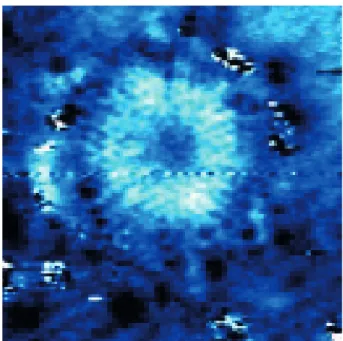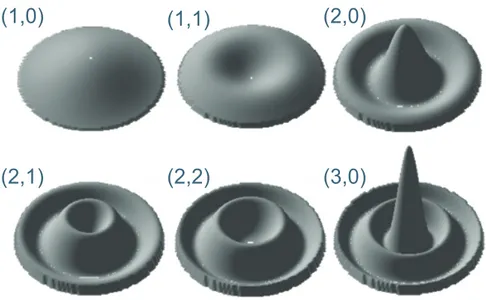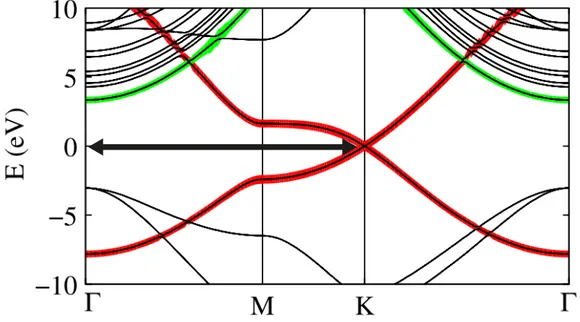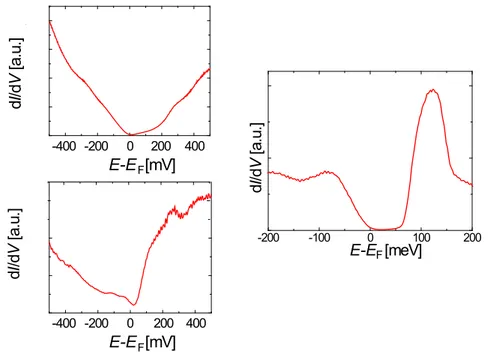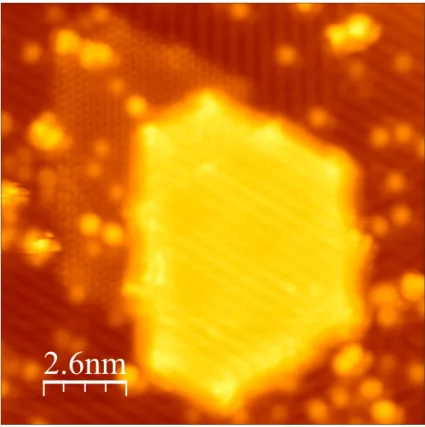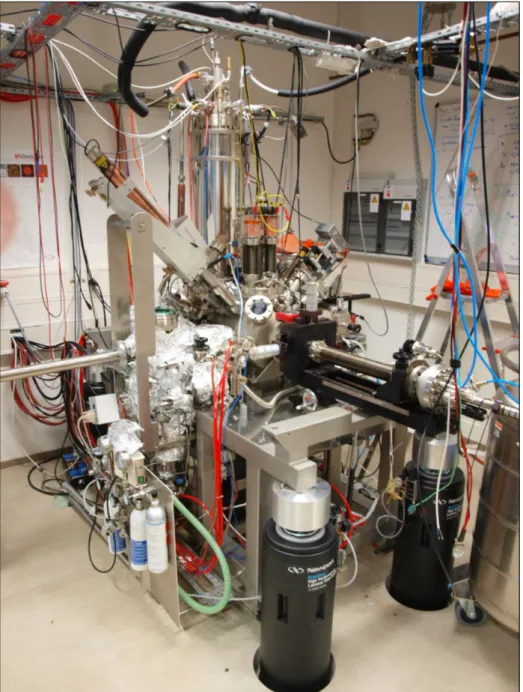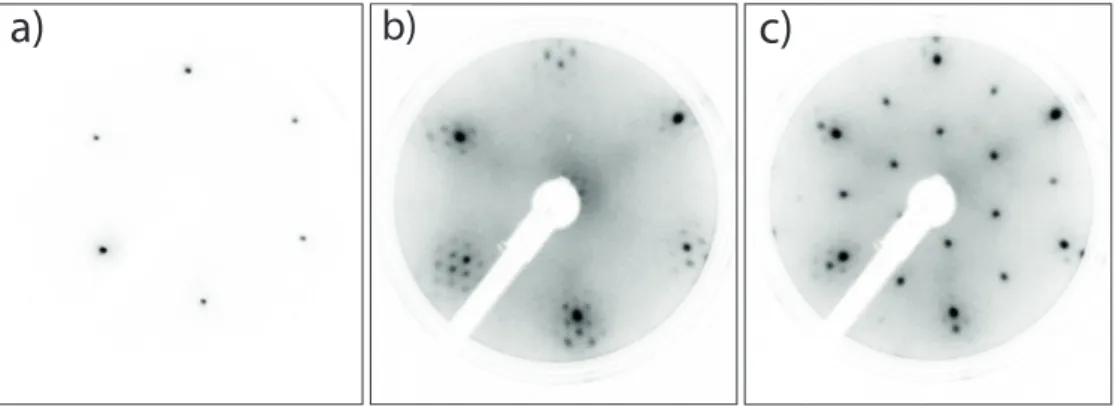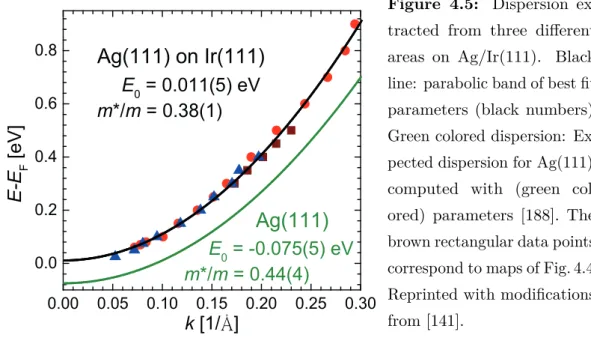Scanning Tunneling Spectroscopy on Graphene Nanostructures
I n a u g u r a l - D i s s e r t a t i o n zur
Erlangung des Doktorgrades
der Mathematisch-Naturwissenschaftlichen Fakultät der Universität zu Köln
vorgelegt von
Diplom-Physiker Fabian Craes
aus Werl
Köln 2014
Erster Berichterstatter: Priv.-Doz. Dr. Carsten Busse Zweiter Berichterstatter: Prof. Dr. Achim Rosch
Vorsitz Prüfungskommission: Prof. Dr. Ladislav Bohatý
Tag der mündlichen Prüfung: 08.04.2014
Abstract
This thesis describes investigations on graphene nanostructures by the means of scanning tunneling microscopy (STM) and spectroscopy (STS) in ultra high vacuum at low temper- ature (5.5 K), focused on their electronic structure on the local scale. The experiments are based on structurally highly perfect epitaxial graphene on Ir(111) [gr/Ir(111)], but extend the range towards new graphene based nanomaterials.
The first topic comprises the development of new nanomaterials which keep the structural coherency of epitaxial graphene on Ir(111) at a reduced electronic substrate interaction, in particular concerning graphene’s quasi-relativistic Dirac particles. Therefor, we present the first study on graphene quantum dots (GQDs) on silver (gr/Ag). In STS, we observe the Ag(111) surface state on 15 ML of Ag on Ir(111), study its behavior in the presence of graphene, and discuss its role in the observation of Dirac electron confinement on GQDs.
We find the surface state suppressed in 1 ML of Ag on Ir(111).
In a next step we present an experimental advancement towards a system, where the metallic surface states are completely absent, namely oxygen covered Ir(111) [O/Ir(111)].
In an STS study, we discover new oxygen superstructures on iridium under graphene and two types of charge effects in the GQDs’ local density of states (LDOS). We present the first unambiguous experimental observation of Dirac electron confinement on GQDs [1]. We calculate the Dirac dispersion relation on the basis of our experimental data and confirm the efficient decoupling by DFT calculations and the direct observation of a Dirac feature in point spectroscopy and characteristic electron scattering processes. In addition to the benefit for the observation of Dirac confinement, our findings gain universal insight into the decoupling of graphene’s electronic system from the metallic substrate by oxygen intercalation.
The studies are extended towards the unoccupied surface state spectrum at high energies
in form of image potential states (IPSs). For the first time we experimentally prove the
size dependence of IPSs due to confinement on GQDs acting as a quantum well [2]. We
explain the occurrence of a strongly pronounced state, which is not the ground state, by
an interplay of the LDOS and momentum conservation during tunneling. The positions
of the IPSs can be tuned by chemical gating, which means the experimental realization
of a quantum well tunable in both width and depth. We discuss the benefit of a direct
measurement of the local workfunction for the determination of the local doping level in graphene intercalation compounds.
In a next step we propose a route how to experimentally access the binding situation at the boundaries of GQDs on Ir(111), using the advanced technique of Inelastic Electron Tunneling Spectroscopy (IETS).
Finally, we observe metallic features in the LDOS which are related to one dimensional
defects in an extended monolayer of epitaxial graphene on Ir(111).
Frequently used Symbols and Abbreviations
ARPES - Angle Resolved Photo-Emission Spectroscopy BZ - Brillouin zone
CVD - Chemical Vapor Deposition DFT - Density Functional Theory (L)DOS - (Local) Density of States fcc - face centered cubic
FWHM - Full Width at Half Maximum FT - Fourier Transformation GQD - Graphene Quantum Dot
gr - Graphene
IETS - Inelastic Electron Tunneling Spectroscopy
L - Langmuir, 1 L “ 1 ˆ 10
´6Torr ¨ s « 1 . 33 ˆ 10
´6mbar ¨ s LEED - Low-Energy Electron Diffraction [3]
LT-STM - Low Temperature Scanning Tunneling Microscope
ML - Monolayer
QMS - Quadrupole Mass Spectrometer
STS/STS - Scanning Tunneling Microscopy/Spectroscopy TPG - Temperature Programmed Growth
UHV - Ultra High Vacuum
XPS - X-Ray Photoemission Spectroscopy
XSW - X-Ray Standing Wave
Contents
I Introduction 1
1 Fundamentals 7
1.1 Scanning Tunneling Microscopy and Spectroscopy . . . . 8
1.2 Angle-Resolved Photoelectron Spectroscopy . . . 13
1.3 Freestanding Graphene . . . 14
1.4 Interacting Graphene . . . 16
1.5 Weakly Interacting Graphene . . . 19
1.6 Surface States . . . 22
1.7 Quantum Confinement of Electrons . . . 26
1.8 Electron Scattering Processes Observed by STM . . . 30
1.9 Imaging Graphene in STM . . . 33
2 Experimental Setup 37 2.1 Ultra High Vacuum . . . 39
2.2 Low Temperature . . . 40
2.3 Damping of External Excitations . . . 41
2.4 Scanning Tunneling Microscope . . . 41
3 Experimental Procedures 43 3.1 Sample Preparation . . . 44
3.2 Data Acquisition and Analysis . . . 49
II Results 51 4 Graphene Quantum Dots on Silver 53 4.1 Morphology . . . 54
4.2 The Ag(111) Surface State . . . 58
4.3 Dirac Feature of Graphene on Silver . . . 62
4.4 Confinement on Graphene Quantum Dots on Silver . . . 64
4.5 Suppressing the Silver Surface State . . . 68
4.6 Conclusion . . . 70
5 Charge Effects on Oxygen Intercalated Graphene Nanostructures on
Ir(111) 73
5.1 Morphology . . . 75
5.2 Observation of Charge Effects . . . 79
5.3 Conclusion . . . 92
6 Dirac Electron Confinement on Graphene Quantum Dots 93 6.1 Morphology . . . 97
6.2 Suppressing the Iridium Surface State . . . 99
6.3 Density Functional Theory . . . 102
6.4 Scanning Tunneling Spectroscopy . . . 103
6.5 Conclusion . . . 107
7 A Quantum Corral without a Fence 109 7.1 Size Dependent Shift of Image Potential States . . . 113
7.2 Preferred State in the Tunneling Process . . . 116
7.3 Mapping Confined Image Potential States . . . 118
7.4 Tuning the Depth of the Quantum Well . . . 122
7.5 Conclusion . . . 126
8 Inelastic Electron Tunneling Spectroscopy on Graphene Quantum Dots127 8.1 Probing the Edge . . . 128
8.2 Conclusion . . . 130
9 Metallic State at 1D Defects in Epitaxial Graphene on Ir(111) 133 9.1 Step Edge . . . 134
9.2 Structural Phase Boundary . . . 139
9.3 Conclusion . . . 140
10 Summary and Outlook 143 10.1 Summary . . . 144
10.2 Outlook . . . 146
III Appendix 147 A Details on Results 149 A.1 Fundamentals . . . 150
A.2 Dirac Electron Confinement on Graphene Quantum Dots . . . 153
A.3 A Quantum Corral Without a Fence . . . 153
B Technical Details on Scanning Tunneling Spectroscopy 155
B.1 Preparing a Spectroscopy Measurement . . . 156
B.2 Point Spectroscopy . . . 157
B.3 Constant Energy d I /d V Mapping . . . 160
B.4 Tip Forming with Vertical Manipulation . . . 162
B.5 d I /d V Energy Resolution . . . 162
B.6 Problems and Solutions . . . 163
C Acknowledgments 165
D Bibliography 169
IV Formal Addenda 195
E Deutsche Kurzzusammenfassung (German Abstract) 197 F Liste der Teilpublikationen (List of Publications) 199
G Offizielle Erklärung 201
PART I
Introduction
Layered and two dimensional materials provide access to exciting new physics as reduced dimensionality both offers a playground for testing important models in solid state physics and is of high relevance for technological applications. Two-dimensional materials differ significantly in their electronic, optical, mechanical and chemical properties from three dimensional bulk systems [4]. Very influential discoveries connected to reduced dimensionality include the quantum Hall effect [5], high temperature superconductivity [6, 7], topologically protected surface states [8], the Dirac electron systems of graphene [9, 10].
In recent years the two dimensional material graphene has become one of the most studied topics in solid state physics. Being the thinnest material in the world, graphene features a variety of stunning properties, ranging from outstanding structural to electronic properties, providing better electrical conductivity than silicon [11], better heat conductivity than copper [12], optical transparency [13, 14] and extreme mechanical robustness while being flexible at the same time [15].
The most striking properties of graphene are covered by its unique bandstructure, providing a usable energy range, where electrons move with a propagation speed independent of their energy, which is a behavior expected for massless particles [9, 16, 17]. Due to their mathematical description in a certain linear approximation, these charge carriers are called Dirac electrons [9]. For the first time revealing these striking features, in 2010 Andre Geim and Konstantin Novoselov were awarded the Nobel Prize in Physics “for groundbreaking experiments regarding the two-dimensional material graphene” [18]. Graphene evokes totally new physics, ranging from a high charge carrier mobility [19], easy doping [20], long spin coherence time [21] and the emergence of chiral edge states [22] to a half-integer quantum hall effect [16] and Klein-tunneling [23].
Two-dimensional materials are produced either directly by in-situ growth processes like the catalytic decomposition of a precursor on a substrate surface or molecular beam epitaxy, or by mechanical or chemical exfoliation from layered bulk crystals [24]. For the preparation of graphene all of these techniques have successfully been used. While actually the first detailed investigations have been performed on mechanically exfoliated layers of graphite [10, 24], an up-scalable process is predestined by liquid exfoliation [25, 26].
The preparation of graphene by in-situ growth processes on a substrate is obtained by
either thermally induced surface segregation from a carbon containing bulk substrate
like ruthenium or carbides (e.g. SiC) [27, 28] or by catalytic decomposition of organic
molecules on a metal surface [29]. These methods are successfully used for obtaining
samples with a high structural coherency [30, 31]. A further method of growing graphene
on metal surfaces is provided by ethylene cracking with an ion source and subsequent
thermally activated decomposition [32], directing the beam of ethylene fractions even to catalytically inactive noble metal surfaces [e.g. Cu(111), Au(111)]. With some of these methods graphene production can already reach the industrial scale with an implication for industrial applications [33, 34]. Potential applications for example include electromechanical devices [35], gas sensors [36, 37], photovoltaics [38], supercapacitors [39], and high frequency transistors [40].
Despite this promising perspective, there are of course obstacles in turning the new physics into applications. These are mainly based on the fact that on the one hand the in-situ growth of graphene on a substrate provides superior structural quality but on the other hand alters its electronic properties which are closely connected to a perfect energetic equivalence of all carbon atoms [41, 42]. Another fact is that in order to use graphene in semiconductor applications [43–45], it has to rest on an insulating substrate [30, 46]. However, playing the game of controlled graphene disturbance can also be a key to exciting new physics as well as applications on its own, since the presence of a tailored substrate enables the tuning of graphene with respect to its electronic and morphological structure, as well as its chemical properties [47–50]. Thus a tailored substrate aims either at quasi-freestanding graphene or tuned properties.
A very flexible way of obtaining such substrates is the intercalation of foreign species between epitaxial graphene and the supporting substrate. Here progress has been made concerning numerous different intercalants yielding a variety of new properties, including the species of oxygen [47, 51], silver [52], caesium [53], europium [49, 50], hydrogen [54], potassium [55], and bromine [56].
This work addresses the ambivalence of the substrate influence on graphene directly, playing with both structural and chemical degrees of freedom in highly tunable graphene systems. The regime of the 2 D material restricted even down to 1 D or 0 D extents reveals new physics, using the combination of scanning tunneling spectroscopy and electron confinement for addressing the electronic properties of the material in a nutshell:
We explore new graphene based nanomaterials with simultaneous structural coherency of
the carbon layer and maximum decoupling from the substrate, reporting on both silver
(Chap. 4) and oxygen intercalated graphene quantum dots (Chap. 5 and Chap. 6). Our
criterion for decoupling is the absence of covalent bonds to the substrate, still allowing
interaction in form of such an amount of charge transfer (doping) that the Fermi level still
resides in the energy range where the charge carriers are Dirac-like. We answer associated
questions referring to the critical parameters for observing Dirac electron features in these
systems and describe a route to suppress disturbing contributions of metallic surface
states to the local density of states. Several new aspects of the local electronic structure
of graphene quantum dots are discovered, namely inducing a shift of the silver surface
state (Chap. 4), new oxygen superstructures on Ir(111) (Chap. 5), charge effects (Chap. 5)
and the confinement of both Dirac (Chap. 6,[1]) and high energy free-electron surface
states (Chap. 7,[2]). Finally, we propose a way how to address the binding character at
the boundaries of graphene quantum dots (Chap. 8) and prove the existence of metallic
wires in one dimensional defects in extended graphene on Ir(111) (Chap. 9). Details on
the electronic structure of graphene, the most relevant aspects on surface electrons and
the envolved experimental techniques are provided in Chap. 1. The sample preparation
routines are discussed in very detail in Chap. 3 and a brief introduction to our experimental
setup appears in Chap. 2.
CHAPTER 1
Fundamentals
In this chapter a dense introduction to the most relevant aspects affecting
this work is given. Starting with the experimental techniques which have
been employed for this work we continue with an introduction into the field
of graphene. We provide an overview on the aspects of electronic behavior in
systems with reduced dimensionality, especially covering the topics of electron
scattering on surfaces and 2D confinement with a graphene bias. Finally, the
latter aspects are discussed from an STM point of view.
1 Fundamentals
1.1 Scanning Tunneling Microscopy and Spectroscopy
The topic of this section will be a brief introduction into the techniques of STM and STS as excellent tools for addressing alterations of the LDOS. Detailed descriptions of the STM principles are presented in Ref. [57].
Scanning Tunneling Microscopy
The scanning tunneling microscope (STM) has been developed in 1982 by G. Binnig and H.
Rohrer [58]. In 1986 they were awarded the Nobel Prize in Physics for this work. Based on the quantum mechanical tunneling effect, the microscope uses a very sharp - in the ideal case atomically sharp - conductive tip above a conductive sample surface in a distance of 5 .. 10 Å , forming two electrodes. In such a small distance the electronic wavefunctions of the closest atom of the tip and the sample overlap. Once applying a bias voltage V
0between them, a tunneling current I sets in. The value of I depends on the LDOS of the tip and the sample, their distance z and the tunneling matrix element (i.e. the coupling of the initial and the final states). The exponential dependence of I on the distance z yields the extremely high vertical resolution of STM: A change in z of 1 Å results in a change in I of approximately one order of magnitude [59]. For imaging, the tip is moved along the surface, using piezo actuators. During this scanning process the distance z is controlled by a feedback loop circuit to a setpoint value of I (in constant current mode). Therefore, STM imaging is mainly determined by five parameters: The bias voltage V
0, the tunneling current I and the spatial parameters z , x , y . According to Bardeen [60], I is given by
I 9 ż
`8´8
|M p E q |
2ρ
Sp E ´ eV
0q ρ
Pp E qr f p E ´ eV
0q ´ f p E qsd E (1.1) with |M pE q| the tunneling matrix element, ρ
SpE ´ eV
0q and ρ
PpEq the density of states of the tip and the sample at an applied bias voltage V
0and fpEq the Fermi function.
A simple theory of STM is derived from (1.1) by Tersoff and Hamann [61], assuming a metallic s-orbital as the tip electrode and a bias voltage V
0which is small compared to the workfunction of the sample Φ
sample( eV
0ăă Φ
sample):
I 9 V
0¨ ρ
Sp E
Fq ρ
Pp R
tip,E
Fq , (1.2)
with ρ
PpR
tip,E
Fq the density of states of the sample surface at the center of the s-orbital
of the STM-tip R
tip. Since the DOS in first approximation decays exponentially into the
vacuum, one obtains an I depending inversely exponential on the distance z :
1.1 Scanning Tunneling Microscopy and Spectroscopy
Ipzq9e
´2κz. (1.3)
For the example of semiconductors eV
0! Φ
sampledoes not hold anymore, therefore the description of I has to be modified. Especially deviating from the simple picture used above (Tersoff-Hamann), a finite energy range defined by V has to be taken into account by integration. A transmission probability (compare to Wentzel-Kramers Brillouin (WKB) approximation) T p V,W q is introduced, depending on V
0and on the workfunction Φ
sampleof the sample surface. With this one obtains I9
ż
EF`eV0EF
|T pV
0, Φ
sampleq|ρ
SpEqρ
PpR
tip,Eqd E. (1.4) The STM can be operated in different modes, depending on how the parameters V , I , and x,y,z are varied. For topographic imaging, all measurement in this work were performed using the constant current mode. This means keeping I and V
0constant while varying the tip sample distance with a z feedback-loop in order to compensate for a varying sample LDOS while scanning the surface in the x and y directions. In this case the voltage which is used to elongate and shrink the z -piezo actuator for the distance variation on each surface coordinate ( x,y ) is recorded as the measurement quantity. Data recording is performed in an assignment of the modus operandi dependent measurement quantity to a matrix of N rows and M columns of discrete ( x,y ) surface coordinate tuples (STM image pixels).
Scanning Tunneling Spectroscopy
Scanning Tunneling Spectroscopy comprises all modes providing access to the LDOS of the surface. The most widely used modes are d I /d V ( E ´ E
F) point spectroscopy and spatial constant energy mapping. Performing d I /d V ( E ´ E
F) point spectroscopy requires fixing the tip-sample distance z at a certain coordinate ( x,y ) on the surface by choosing an appropriate setpoint of a bias voltage V
0and a tunneling current I with closed feedback-loop and performing a subsequent onsite voltage sweep with open feedback-loop.
The latter means that the variation in the tunneling current as the measurement quantity
during the voltage sweep is not influenced by a varying orbital overlap of the tip and the
sample states by varying the tip-sample distance. Thus, the measurement signal is IpV q
depending on the sample LDOS at energies defined by eV “ E ´ E
F. Decisive aspects are
the stability of the tip-surface distance (and also lateral position) regarding thermal drift,
the suppression of diffusion processes at the tip and the sample, and an improved energy
resolution (see below). Therefore, STS measurements are generally performed at low
1 Fundamentals
temperature (5.5K). According to Tersoff and Hamann the DOS at a surface coordinate is proportional to the differential conductivity d I /d V at fixed V
0[61, 62]:
d I
d V 9|T |
2ρ
SpE
Fqρ
PpE
Fq. (1.5) Since the transmission probability is difficult to access, |T | is often approximated by the total conductivity of the tunneling junction I {V [62]. The approximation works well for higher energies (several hundreds of meV to eV) and is problematical close to zero voltage since I p V “ 0q vanishes and thus I { V diverges.
Experimentally these values can be accessed by a direct measurement of
dVdIusing the lock-in technique [61]. Therefor a weak AC voltage V
modcosp ω tq is added to V
0:
V “ V
0` V
modcospω tq.
The resulting tunneling current I is used as an input signal to a lock-in amplifier. This filters the ω AC fraction of the tunneling current via an integration of the product of I with a reference signal with the same frequency ω . As obtained by a Taylor expansion at V
0in first order, the amplitude of the AC current fraction is proportional to d I /d V , and in second order proportional to the second derivative [63]:
IpV
0` V
modcospω tq “ IpV
0` ∆ V q
» I p V
0q ` dI p V q
dV p∆ V q ` d
2I p V q dV
21
2 p∆ V q
2` ...
» IpV
0q ` dIpV q
dV pV
modcospω tqq ` d
2IpVq dV
21
2 pV
modcospω tqq
2` ...
» IpV
0q ` dIpV q
dV pV
modcospω tqq ` d
2IpVq dV
21
4 V
mod2p1 ` cosp2 ω tqq ` ...
The output signal of the lock-in amplifier can therefore be used for direct spectroscopic representation [64], either in d I /d V point spectra or in d I /d V spatial mapping at constant energy. In case of the latter one, a constant current topograph (integrated density of states) and a spatial map of the lock-in signal d I /d V at a fixed bias voltage V
0are recorded simultaneously. One obtains a spatial distribution of the LDOS at an energy E “ E
F` eV . STS provides the most local technique for spectroscopic investigations on a surface.
Difficulties include the facts that in reality the tip is not featureless in the sense of a free
electron gas as assumed in many calculations that due to vanishing tunneling transmission
probability it is impossible to measure sample states that do not overlap with states of the
tip and that it lacks chemical sensitivity. Controlling the microscopical shape of the tip
and thus the orbital which is involved in the tunneling process remains though, although
1.1 Scanning Tunneling Microscopy and Spectroscopy there are numerous efforts reported in literature for certain tip-sample combinations, e.g.
by adding molecules to the tip [65] or in spin-polarized STM [66].
The energy resolution depends on the temperature and the bias modulation used for the lock-in technique. According to [67] it amounts to:
∆ E “ ˘ 1 2
b
p3 . 3 k
BT q
2` p1 . 8 eV
modq
2.
Details of the lock-in preferences and parameters used for this work are described in Chap. B.
Inelastic Electron Tunneling Spectroscopy
As mentioned above, the second derivative is proportional to the second harmonic lock-in signal. Now I would like to draw a connection to the associated phenomenon of inelastic electron tunneling.
Inelastic Electron Tunneling Spectroscopy (IETS) in a simple picture is based on the fact that the charge transfer occurring with tunneling is able to cause a temporary charge redistribution in the object under investigation on the sample surface (e.g. a molecule) which is related to a change in molecular bond length. Since this redistribution might relax by exchanging charge with the substrate, a vibrational mode (phonon) is created and therefore directly connected to the tunneling current [68]. The tunneling process thus becomes inelastic via the relaxation process. Inelastic processes might also include the emission of light. The tunneling process mentioned is only possible if the connected phonon energy is allowed in the system. Thus, in the d I /d V spectrum this process will appear as a second tunneling channel in addition to the standard tunneling process generally assumed to be elastic. It shows a sudden step-like increase in the signal at a certain threshold energy (the phonon excitation energy ~ ν ) for both positive and negative bias voltages. The steps in d I /d V of course correspond to peaks in d
2I /d V
2, which is therefore a suitable quantity in IETS (see Fig. 1.1). Due to this mechanism, the most important criterion for identifying peaks in the second derivative of the I pV q characteristics as signatures of inelastic tunneling is their ˘~ ν mirror antisymmetry in energy with respect to 0 V ( E
F):
Of course the direction of current does not induce any change to the excitation process.
The principles of charge redistribution and relaxation remain the same.
IETS is widely used to study molecular excitations on the local scale, requiring not more
than just one single molecule, making it the most sensitive technique for vibrational
excitation studies (e.g. [63, 69–71]). Another advantage is that, compared to infrared
(IR) and Raman spectroscopy [72], also optically forbidden excitations can be observed.
1 Fundamentals
Figure 1.1: (a) Schematic representation of elastic a and inelastic b tunneling processes between two electrodes (e.g. STM-tip and sample) at an applied bias voltage. (b) Conductivity IpV q (top) and its second derivative (bottom), indicating the features of the curves associated with elastic a and inelastic b tunneling processes. Reproduced from [69] with permission of The Royal Society of Chemistry.
Having its roots in metal/oxide/metal tunneling junctions (e.g. [73, 74]), it can be also realized in fixed-point STS as well as in STS spatial mapping [68, 75–78]. In the framework of this work it is therefore referred to as STM-IETS. This measurement technique has been extensively developed and used by the group of Wilson Ho [75, 79]. Via molecular excitations, STM-IETS provides chemical sensitivity in an indirect way which is lacking in elastic STM and STS.
In general STM-IETS requires the use of two lock-in amplifiers with a synchronized
reference signal, since this combination enables the simultaneous measurement of d I /d V
and d
2I /d V
2. In the framework of this thesis STM-IETS is applied for investigations on
the boundaries of GQDs presented in Chap. 8.
1.2 Angle-Resolved Photoelectron Spectroscopy
1.2 Angle-Resolved Photoelectron Spectroscopy
Angle-Resolved Photoelectron Spectroscopy (ARPES) is an experimental technique pri- marily aiming at the investigation of the occupied electronic structure in the reciprocal space of a solid’s surface and near-surface region. It also yields information on the lifetimes of excited states. ARPES is based on the photoelectric effect, measuring the kinetic energy of electrons emitted from the surface of an initial state with binding energy E
Bin the solid after absorption of a photon with energy ~ ν [59]. In the framework of this work photons were created with a helium discharge lamp (ultraviolet photoelectron spectroscopy). The kinetic energy of the photoelectrons leaving the surface is measured with an electron energy analyzer.
Often, the process is treated as a three-step process : The ‘optical excitation between the initial and final bulk Bloch eigenstates, travel of the excited electron to the surface, and escape of the photoelectron into vacuum after transmission through the surface potential barrier’ [80].
For the energy the process yields
E
kin“ ~ ν ´ Φ ´ E
B(1.6)
with Φ the workfunction and E
Bthe binding energy. If the translational symmetry of the sample surface is conserved, the in-plane component of the initial state momentum is also conserved:
~ k
ik“ ~ k
fk“ ~
´1a 2 mE
kinsin θ (1.7)
with θ the polar angle. Since the translational symmetry is not conserved in normal direction to the surface, k
Kis also not conserved. Details on ARPES are described in Refs. [80, 81].
The unoccupied spectrum can be probed using a more complex process called two-photon photoemission. Here, using a pulsed laser, a photon is used to excite an electron into an intermediate state in the unoccupied spectrum, a second one is used to probe the excited state in a photoemission process [82, 83].
In this thesis ARPES measurements are involved in the investigations on quantum con-
finement of Dirac electrons (see Chap. 6).
1 Fundamentals
1.3 Freestanding Graphene
Figure 1.2: Honeycomb lattice and its Brillouin zone. Top left: hon- eycomb lattice structure of graphene, made out of two interpenetrating triangular lattices (a
1and a
2are the lattice unit vectors, and δ
i, i “ 1,2,3 are the nearest-neighbor vectors). Top right: corresponding first Brillouin zone in reciprocal space with unit vectors b
1and b
2, K and K
1points.
The Dirac cones are located at the K and K
1points. Bottom: energy spectrum in the units of the hopping parameter t as obtained from a tight binding calculation [9, 84]. Reprinted figures with permission from [9]. Copyright 2009 by the American Physical Society.
Freestanding graphene provides the basis for understanding the electronic structure in
absence of the complications induced by interactions with a substrate. The following
section gives a brief overview on the most important electronic properties of freestanding
graphene. For a more detailed introduction the reader is referred to literature, e.g. the
reviews of A. H. Castro Neto [9] and A. K. Geim [10].
1.3 Freestanding Graphene Graphene is formed by one monolayer of sp
2hybridized carbon atoms in a honeycomb lattice, thus providing in total three sp
2and one p
zorbital at each of the two identical atoms in a unit cell. The structure can also be viewed as a superposition of two displaced triangular sublattices [9]. In the honeycomb lattice structure each atom is bound to three neighbors with a nearest-neighbor-distance of a
nn“1 . 42 Å
1, resulting in three orbitals forming interconnecting σ bonds in-plane and leaving one p
z-orbital out-of-plane. The neighboring, half-filled p
zorbitals also overlap and form graphene’s π -system, giving rise to a delocalized electron system.
The unique electronic properties of graphene are intimately connected to the bandstructure at the K and K
1points in the Brillouin Zone (BZ) (Dirac points, see Fig. 1.2) where the bonding and anti-bonding π bands touch at an energy E
D“ E
Fwith E
Dthe Dirac energy and E
Fthe Fermi energy (see Fig. 1.2). The band structure can be calculated with a tight-binding calculation [9, 26, 84], leading to
Epqq “ ˘t d
3 ` 2 cos ´ ? 3 k
ya
nn¯
` 4 cos ˆ ?
3 2 k
ya
nn˙ cos
ˆ 3 2 k
xa
nn˙
with t the nearest neighbor hopping energy, the - sign for the occupied π -band, + for the unoccupied π *, a
nnthe nearest neighbor distance, and q “ k ´ K the wavevector measured with respect to the K point.
At the Dirac points the bandstructure can be described in a linear approximation, using two-component wave functions and the 2 D relativistic Dirac-Weyl equation for massless quasiparticles [9, 10] with the Hamiltonian
H “ v
fσq.
The two-component wave functions resemble properties of a spinor wavefunction and give rise to a pseudospin variable [9].
In this model, graphene’s electrons at the K points feature an energy-independent propa- gation speed with a (Fermi) velocity of v
F“ 1 ˆ 10
6m/s [85]. The character of graphene as a zero bandgap semiconductor is closely related to the perfect sublattice symmetry in freestanding graphene, with two identical C atoms in the unit cell. Unique properties like e.g. the anomalous integer quantum Hall effect [86], Klein tunneling [23] and 1D edge states [9] and Zitterbewegung [87] are related to the exceptional electronic features. Note that due to the low density of states in the vicinity of E
Ddoping of graphene is highly effective and is achieved even by backgating [20].
1


